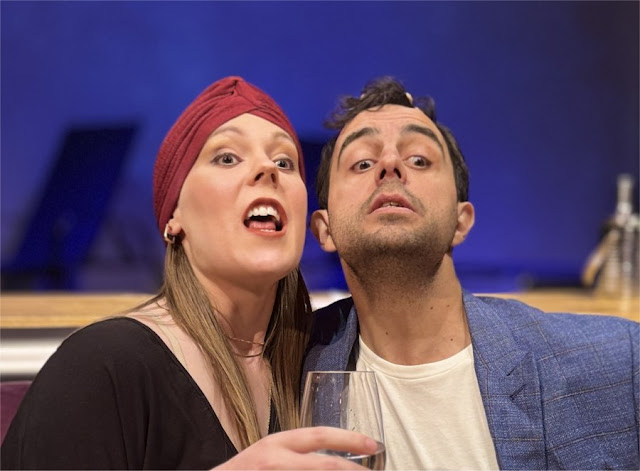Visual Art Exhibition Review | Brian
Rope
A South Coast Selection | Heide Smith
Basil Sellers Exhibition Centre (BAS), Moruya | 28 June - 26 July 2025
Heide Smith (then Soltsien) trained, then worked, as a photographer in her native Germany. After meeting and marrying Brian Smith, a British Army officer stationed in Germany, she continued working as a photographer – initially in Britain and Europe then, following migration, in Australia. She worked in Canberra from 1978 to 1998, then on the NSW South Coast. This photo artist’s own website quotes her as saying she believes that “Once a photographer, always a CAMERA WOMAN.”
I’m not sure when I first met this renowned photographer, but I still have my jotted notes of her helpful comments whilst judging the entries (including mine) at a Canberra Photographic Society competition in July 1986. “If the lighting is very contrasty, slightly overexpose then underdevelop with good agitation” and “For portraits, light up the shorter side of the face.” Of course, to follow her first piece of advice in those words, we need to be shooting film and processing it in a darkroom.
From 1984 to 1996, Smith was the official photographer for the National Press Club in Canberra. Working from an office in the Club’s building during four of those years, I attended various events and observed her photographing their high-profile speakers, including politicians, ambassadors, artists and actors. People such as writer and journalist Phillip Adams, the head of the International Atomic Energy Agency Hans Blix, US President George Bush Senior, philosopher and political activist Noam Chomsky, actor Audrey Hepburn, and His Holiness the Dalai Lama.
Smith is best known for her meaningful portraits and documentary-style photography, capturing the authentic essence of people and places. Her most iconic works include a culturally significant series documenting the Tiwi people of Northern Australia, and extraordinary images of Cambodia as a country in transition. And an extensive visual chronicle of Canberra, including her 1991 portraits of Canberra Raiders as a fundraising venture for the then financially struggling Rugby League club.
Throughout her career, this artist has published eleven books, held numerous exhibitions, and received prestigious accolades, including an Honorary Fellowship and a Fellowship from the Australian Institute of Professional Photography. Many Canberrans, myself included, purchased copies of her five books about Canberra. The final one A Portrait of Canberra and Canberrans 1979-2012 was published to celebrate Canberra’s Centenary, is one of only two of her books still available for sale in her bookshop. The other available for purchase is Portrait of a People – the Tiwi of Northern Australia.
 |
| Screenshot taken from https://heidesmith.com/canberra-collection/ |
Her
new exhibition, A South Coast Selection, showing at the Basil
Sellers Exhibition Centre in Moruya, highlights Smith’s deep relationship with
the south coast of New South Wales (Australia) where she has lived since the
late 1990s. Her images allow visitors to absorb the area's unspoiled beauty,
uniqueness, and sense of community. Every one of them displays her
characteristically warm and clear style, whether it be a personal portrait or
an expressive landscape.
It is more than a showcase of images - it’s a celebration of place, people, and the timeless ability of photography to tell stories of importance. Stories of the coastline itself, but also of the ranges and forests which provide its backdrop. Places such as the much-loved Gulaga, sacred mountain for the Yuin people, being severely damaged by bushfire. Tranquil afternoon reflections amongst forest and mangroves at Hobbs Point. Fabulous pelicans on Coila Beach. A stunningly red sunset on Lake Wapengo. And glorious mist amongst the forest at Belimbla. Then there are stories of some most interesting people such as the late architect and photographer Bruce Loder, and Guboo Ted Thomas - land rights activist and a tribal Elder of the Yuin nation who grew up on the Wallaga Lake Reserve near Narooma.
 |
| Gulaga Burning, 2009 © Heide Smith |
 |
| Belimbla, 2004 © Heide Smith |
 |
| Lift Off at Tuross Coila Beach, 2018 © Heide Smith |
 |
| Wapengo Red, 1986 © Heide Smith |
 |
| Bruce Loder, 2004 © Heide Smith |
 |
| Ted Guboo Thomas, 1986 © Heide Smith |
There are 43 framed prints on display, all printed by Smith, plus a 27 minutes video introduction to the new book launched at the opening of the exhibition. FotoHeide A Photographer’s Tale, by husband Brian, is the story of Smith’s remarkable career. It will be the subject of a separate review.
This review is also available on the author's blog here and in The Printer here. A shorter version has been published on the Canberra City News website here.
















%20Jill%20Ogai_Callum%20Linnane%20Credit_Kate%20Longley.jpg)
%20Jill%20Ogai_Callum%20Linnane%20Credit_Kate%20Longley.jpg)
%20Jill%20Ogai_Brett%20Chynoweth%20Credit_Kate%20Longley.jpg)
%20Jill%20Ogai_Callum%20Linnane_Brett%20Chynoweth%20Credit_Kate%20Longley.jpg)

.jpg)











